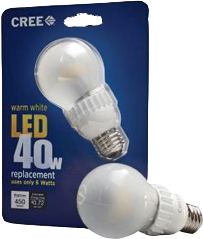March 23, 2013. Not the first crocuses and daffodils. The first under-$10 LED light bulbs. Just in time for Spring gleaming.
If you’ve been reading BCS for a while, you’ve probably seen my annual LED light bulb report. Watching these amazing things get Better and Cheaper. And Slower to burn out. In 2010, you could buy one that lasted 20 years and saved you nearly $300 in electric bills during its two decades of service. But it cost almost $30 for one bulb.
Now you can get one for a little less than $10. Which may ring a bell and light up a little light bulb cartoon bubble above your head. Here’s why it should.
Why to buy
They’re Better because they reduce electricity consumption by 80 – 90% (compared with incandescent bulbs). Which makes them much Cheaper in the long run because they lower your electric bill. They have a really long run, so they’re way Slower to burn out and need replacement.
Some background: the wattage of a bulb refers to the amount of electricity it uses, not the amount of light it produces. The old-fashioned 60-watt bulb uses 60 watts of electricity; a 9-watt LED bulb uses only 9 watts, but produces about the same illumination.
The old 60-watt incandescent costs about 75 cents and has a lifetime of about 1,000 hours. If you use it four hours per day for 365 days (that’s 1460 hours), you’ll replace it before the year is up. At the electric rate of 15 cents per kilowatt hour, you’ll spend $13.15/year to power that light fixture – and $315 for 24 years. During which you’d have to buy (and change) 35 new bulbs at a total cost of $26.
The LED alternative will cost you $1.09 a year in electricity. It should last for up to 35,000 hours – that’s 24 years if you use it 4 hours/day. During those 24 years it’ll use $26.25 worth of electricity, compared with $315 you’d spend to power those 35 incandescent bulbs you’ll be screwing and unscrewing.
So what’s the catch? The 60-watt equivalent-brightness LED light bulb costs $13 today (compared with $26.25 for 35 incandescent bulbs). The 40-watt equivalent costs $10. If you can get past the one-time purchase price, it’s a great investment.
What to buy
The $10 price breakthrough is the Cree 6-watt (40-watt equivalent) on sale now at Home Depot. The 9-watt (60-watt equivalent) is there for $13 and at Amazon.com for $15. As it turns out, the Cree* bulbs are both cheaper and better. Better in terms of quality, color and consistency of the light they produce. If you want to see more about the quality of light issue, here’s my 2010 LED report.
Next best: this 7-watt (60-watt equivalent) from Lighting EVER.
Better than Cheaper: FREE
Win a free LED light bulb. Yup, I’ll send you one. When I tested the new ones, I replaced those older $30 LED bulbs. Now I have some “slightly used” bulbs that probably still have 20,000 hours left on them. So let’s have a short essay contest. The winner(s) get free bulbs. In one short paragraph, tell me why you’re most deserving and how you’ll use your bulb. How’s that for Better Cheaper? A free LED light bulb that saves you $300 in electricity.
LIKE Better Cheaper Slower and post your paragraph on Facebook
* Full disclosure: Cree is the current technology leader in LED lighting products. They’re located in North Carolina. I own a small amount of their stock. I’m not praising their products because I bought the stock; I bought the stock because I’m impressed by the products.
Cost-Benefit Analysis
Save $287 per light bulb during the next 24 years
Planetary Cost-Benefit
The U.S. Department of Energy estimates that widespread adoption of LED lighting in the U.S. over the next 15 years can:
* Deliver savings of about $280 billion.
* Avoid 133 new power plants.
* Reduce lighting electricity demand by 62% in 2025.
* Eliminate 258 million metric tons of carbon emissions.
What makes this so cool?
Light-Emitting Diodes (LEDs) make light by passing electrons through a semiconductor; they produce very little heat and are cool to the touch. In traditional bulbs, electricity heats a metal filament until it’s so hot it glows; 90% of the electricity becomes heat, only 10% becomes light.
If your household is typical, about 9% of your electrical cost goes to lighting; another 15% goes to air conditioning! So cool-running LED bulbs help reduce that cost, too. And when it’s time for your next computer or TV, look for screens that use LED backlighting. They look better, they use less electricity and they generate less heat.

